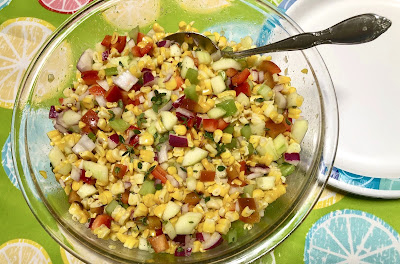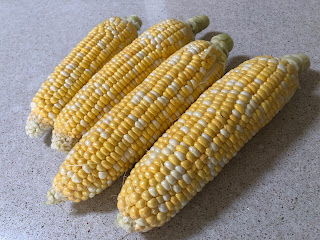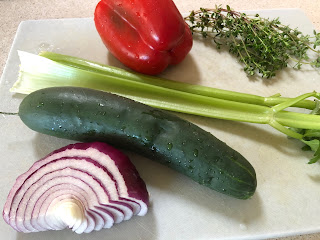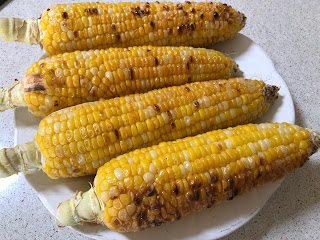
Recipe: Chopped veggies in a light vinaigrette can cope with heat
 |
|
Ready for the cookout: This colorful salad can be
served cold or room temperature. (Photos:
Kathy Morrison)
|
Oh, that forecast! Why did the hottest day of the month have to be Memorial Day? Anyone planning an outing or (fully vaccinated) home gathering Monday will have to factor in that predicted 104-degree or higher weather. And of course around here the temperature peaks just as you're getting ready to prepare or serve dinner.
This salad is my suggestion for the cookout table. The only cooking required can be done ahead, most of the vegetables are raw, and the dressing does not contain risky-in-heat mayonnaise. The salad can be served cold or room temperature, and is versatile enough to tweak to family tastes.
The base is the wonderful fresh corn now coming into market. The ears are roasted under the broiler or on the grill, and the roasted kernels stripped off to become the dominant vegetable in the salad. Also in there for color and texture are red bell pepper, celery, red onion and cucumber; easy additions or substitutions could include sun-dried tomatoes, sliced olives or chopped carrots. The thyme could be switched out for fresh basil or parsley, too.
 |
| Four ears of bicolor corn went into this recipe. |
Roasted corn salad
Makes 4-6 servings; easily doubled
Ingredients:
4 or 5 ears of corn, husked
2 tablespoons olive oil
1 red bell pepper, seeded and diced
2 or 3 celery stalks, quartered lengthwise and diced
1 cucumber, peeled and seeded, then diced
1/2 large red onion, diced
Other possible additions: 1/2 cup or more sliced sun-dried tomatoes; 1 cup sliced olives; 3/4 cup diced or shredded raw carrots
Dressing:
Leaves from 1 bunch of fresh thyme, roughly chopped (1 generous tablespoon), plus more leaves for garnish if desired
 |
|
This is the supporting cast. I used about half the
thyme in that bunch, which was just trimmed off
the plant. |
1/3 cup cider vinegar
2/3 cup extra virgin olive oil
Salt
Freshly ground black pepper
Instructions:
Preheat the broiler or the grill. Brush the ears of corn with the 2 tablespoons olive oil and broil or grill until they're roasted on all sides, turning frequently to avoid burning. (Corn has a lot of sugar and can burn quickly) Let cool.
Combine the chopped bell pepper, cucumber, red onion and celery in a large bowl.
Whisk together the cider vinegar and about 1/2 cup of the olive oil, the thyme leaves, about 1/4 teaspoon salt and several grinds of pepper. Taste, and add more olive oil if desired, and correct the seasonings to taste.
Add a touch of salt and several grinds of pepper to the veggies already in the bowl, if desired. (I like pepper with corn, so I tend to use a lot.)
 |
|
The corn cools after roasting. Use tongs to turn them
often while they're cooking.
|
Cut the kernels off the cooled cobs and stir them into the bowl with the other veggies. Re-whisk the dressing and pour about half of it over the vegetables, mixing thoroughly.
Cover and chill the salad until ready to serve. (One hour at least is best for flavors to meld.)
Comments
0 comments have been posted.Sacramento Digs Gardening to your inbox.
Sites We Like
Garden Checklist for week of April 21
This week there’s plenty to keep gardeners busy. With no rain in the immediate forecast, remember to irrigate any new transplants.
* Weed, weed, weed! Get them before they flower and go to seed.
* April is the last chance to plant citrus trees such as dwarf orange, lemon and kumquat. These trees also look good in landscaping and provide fresh fruit in winter.
* Smell orange blossoms? Feed citrus trees with a low dose of balanced fertilizer (such as 10-10-10) during bloom to help set fruit. Keep an eye out for ants.
* Apply slow-release fertilizer to the lawn.
* Thoroughly clean debris from the bottom of outdoor ponds or fountains.
* Spring brings a flush of rapid growth, and that means your garden is really hungry. Feed shrubs and trees with a slow-release fertilizer. Or mulch with a 1-inch layer of compost.
* Azaleas and camellias looking a little yellow? If leaves are turning yellow between the veins, give them a boost with chelated iron.
* Trim dead flowers but not leaves from spring-flowering bulbs such as daffodils and tulips. Those leaves gather energy to create next year's flowers. Also, give the bulbs a fertilizer boost after bloom.
* Pinch chrysanthemums back to 12 inches for fall flowers. Cut old stems to the ground.
* Mulch around plants to conserve moisture and control weeds.
* From seed, plant beans, beets, cantaloupes, carrots, corn, cucumbers, melons, radishes and squash.
* Plant onion sets.
* In the flower garden, plant seeds for asters, cosmos, celosia, marigolds, salvia, sunflowers and zinnias.
* Transplant petunias, zinnias, geraniums and other summer bloomers.
* Plant perennials and dahlia tubers for summer bloom.
* Mid to late April is about the last chance to plant summer bulbs, such as gladiolus and tuberous begonias.
* Transplant lettuce seedlings. Choose varieties that mature quickly such as loose leaf.